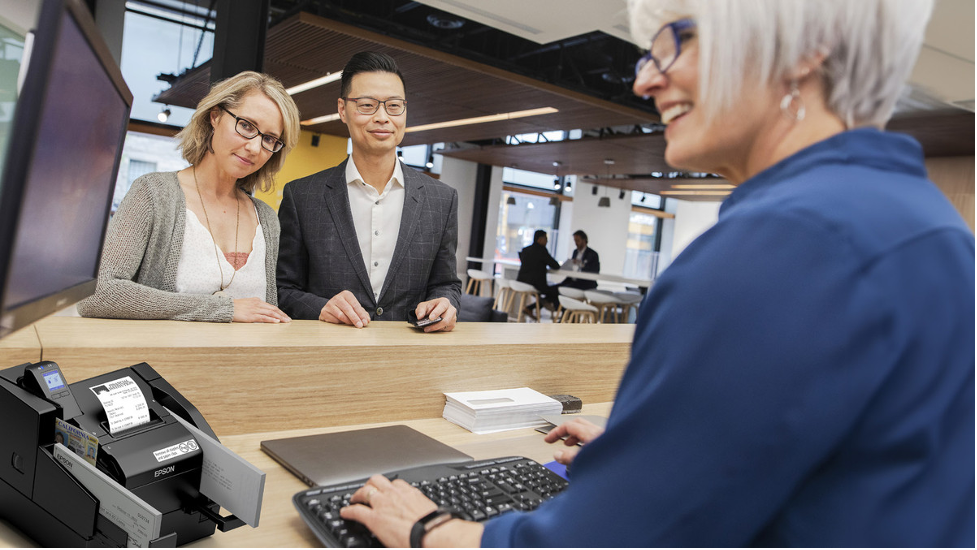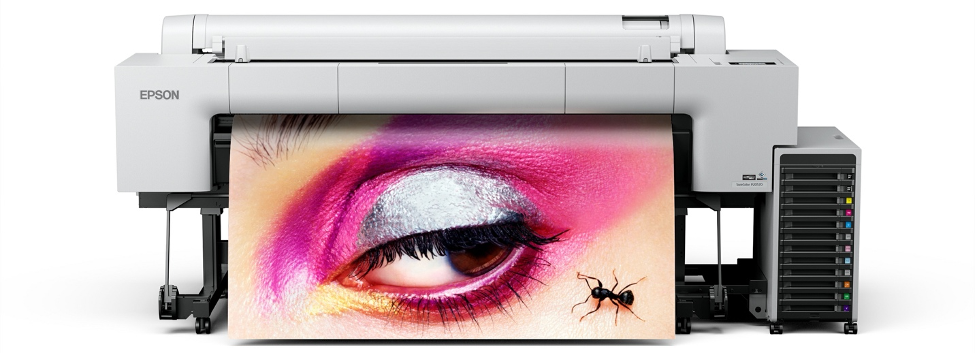By Andy Slawetsky – Epson invited about 30 guests, including nearly 20 US dealers, 4 members of the press, IDC, BLI and the BTA president Brent Hoskins to come see their HQ and factories in Japan October 30 – November 2. Titled “Business Inkjet VIP Tour Japan,” Epson spared no expense, flying each of the dealers over business class and treating them to an incredibly well-run and highly impressive tour.
Epson is a $10 billion company and is a monster in the inkjet world. Known for their home and low-end desktop printers as well as sophisticated graphics and wide format printers, they began pushing into the office with their first A3 MFP a few years ago and since then, they’ve slowly but surely progressed, bringing in senior management like Mark Mathews, previously president and CEO of Toshiba America Business Solutions to build a dealer channel in 2017. Earlier this year, Mark, VP North American Commercial Sales and Marketing brought in another Toshiba VP, Joe Contreras, now Commercial Marketing Executive – Office Solutions, to further the program and to increase Epson’s presence in the channel.

Mark mentioned to me several times on this trip that Epson has always been pretty conservative when it came to promoting themselves and their strengths and it’s time to let the industry know who they are. This trip was a statement event and the dealers on it were impressed, not because Epson spent some money on them (these guys are all very successful and can fly to Japan when they want a trip), but because of what they saw, which I will try to describe to you.

The people on this trip were not all BTA dealers. In fact, there were three dealer groups represented with BTA, RSA and RMX Network dealers on the tour. There were a lot of people on this trip that I hadn’t had the pleasure of meeting before and it was great to spend so much time with them over the 4 days. Mark told us at some point that the dealers on this trip collectively represent $1B in US annual sales. Not a bad group! With that, here’s who I spent my week with:
- Tony Westbrook, Coastal Reprographic Services
- Kevin Howes, Reprographic Services Association
- Dan Hollembaeck, Integrated Business Solutions
- Mike Murray, Integrated Business Solutions
- Keith Hillen, Complete Business Systems
- Mary Hillen, Complete Business Systems
- Ron Nielson, Flex Technology Group
- Andy Archer, Automated Business Products
- Joe Reeves, Smile Business Products
- Kevin Marshall, Copy Link Inc.
- Kara Stager, Print-O-Stat, Inc.
- Daniel Gabrich, BlueEdge
- Kevin Van Kannel, UTEC
- Mike O’Keefe, R.S. Knapp
- Bruce Franz, Franz Reprographics
- John Eckstrom, Carolina Business Equipment
- Terry Willcox, Seminole Office Solutions
- David Ramos, Visual Edge Technology
- Monte Sloan, JD Young
- Rick Bosworth, RMX Network
- Chip Miceli, Pulse Technology
Most of us arrived during the day on Wed. the 30th and we kicked off with a welcome dinner at the hotel, overlooking Tokyo. Mark opened the evening with a short speech and we ate and chatted and called it a night early as the guests were pretty exhausted from their journey.
We started the next morning with a 3 hour bus ride from Tokyo to Epson’s headquarters in Hirooka. It was actually nice to chat with old and new friends during the trip while taking in the incredible scenery.

About 20 minutes from our destination, we stopped for lunch. Japan is big on box lunches and they are works of art more than just a sack full of food like we tend to get over here. As this was my first trip to Japan (how is that possible???), I had never experienced food presentation like this and such attention to detail. One of the box lunches was self heating. Pull the string and in 10 minutes it was piping hot!

Set on a lake close to HQ, we mingled at our lunch stop, took some beautiful photos and eventually finished the last short leg.

Upon arriving at HQ, we entered the building and spent some time checking out the lobby and all the technology they had spread throughout, including a Formula 1 car (I think), showcasing Epson’s sponsorship. It was also a great opportunity for a photo op.

Shortly after, we were brought to a conference room where we were introduced to our hosts, the senior executive team at Epson. After a short welcome by Mark, we jumped right in. This is where it gets challenging as much of the meeting was under NDA and we weren’t allowed to take photos of the slides for this portion.

COO Mr. Koichi Kubota began, talking about Epson’s start in 1942 as Seiko Epson, which was an attempt to use advanced precision technologies to build watches to compete with the Swiss. In 1968 they came out with their their first electric printer (that’s what EP stands for on many Epson models).

Today, almost 70% of Epson’s business is printer related with 20% coming from Visual Communications and the remaining 10% coming from robotics, wearable technology and more. While robotics are currently a smaller part of Epson’s overall revenue, this number should dramatically increase going froward.

Revenue for Epson is split fairly evenly across the globe, with 38.5% coming from the Americas, 23% from Japan, 27.8% coming from Asia Oceana and 20.7% from Europe.
Epson employs 76,647 people worldwide. As I said, they’re a $10B company and by my math, that means they’re getting about $7B from their print operation.
After some more background, we then jumped into inkjet. Epson is #1 in inkjet in both the US and Japan. Their Piezo technology, created by President and CEO Minoru Usui is quite different than the inkjet technology from competitors, something Epson is very proud of and they made a strong case for it being significantly better. Im not saying it is, but they put some interesting data in front of us during this session.
Click here to see all event photos!
This piezo technology, branded as Precision Core is the big differentiator between Epson and brands C and H. While Precision Core pushes ink through the jets using a squeezing process, the others use heat to physically boil the ink until it sprays out. Both processes achieve the desired effect, but the Epson method uses considerably less energy as they do not need to generate the heat in order to boil the ink. According to Epson, this a huge advantage that results in lower power usage and increased reliability when compared to other inkjet processes.
We were told that the Epson heads last considerably longer than brands that use “thermal” inkjet technology (heat) as they eventually need to be replaced. Again, with no boiling process involved, the print heads do not get as stressed and can run almost indefinitely with the Precision Core technology. After several more presentations, we were starting to get it; heat bad, cool good.
We were now off to see technology in other parts of the building that I mostly can’t tell you about…not yet anyways. We were split into groups and shown around to different rooms.

After the demonstrations, we were back in the conference room where it was Q and A time. As a chatty member of the press core, I got my questions ready and figured I better have a few locked and loaded. After all, we had 30 minutes and dealers usually get shy in front of each other, especially when they don’t know everyone. Not this time.

The questions came fast and furious from these dealers and none of the journalists even had a chance to ask anything, which was fine, we all have access to Joe, Mark and Epson PR representative Darek Connole (hey, look who made the article!). Epson is really good about providing access at the highest levels to us.

Hearing these dealers and their questions was one of the best parts of the trip. I don’t think anyone was expecting the level of interest and questions that came from this group. What was really interesting were the differences between the dealers. Someone would tell Epson they wanted more engines and shortly after another dealer would tell them not to make too many printer versions. It was like herding cats. These guys were all over the place with their advice and none of them were wrong.
I think it opened a lot of eyes on the Epson side of that room. These are all independent businesses and there is no cookie cutter approach that will satisfy everyone. The huge Epson team was taking notes as fast as they could, barely keeping up with the suggestions, comments and requests coming from this crowd. It was awesome and it actually had to be shut down due to our tight schedule, with dealers being told that Epson people would follow up with them individually. What a great Q and A.

That evening we were taken to a nice local restaurant where we had the chance to meet and dine with President and CEO Minoru Usui. What an honor! After a lovely meal and great conversation, a few of us hit the hotel bar for a nightcap (thank you Kevin Van Kannel!) and ended early, preceded by John “Irish Goodbye” Eckstrom (busted).
The next morning we were taken to a manufacturing plant where we were put into bunny suits and taken into the cleanest clean room I have ever seen. This wasn’t my first time in one of these, but I had never gone through this level of delousing before. They dressed us and we were wrapped tight with gloves on top of our gloves (seriously…2 layers), legs were put into boots that were also tied up, hoods, facial masks…the whole thing was pretty amazing and it was not a quick process. People working in this area do this every day! If you have a baby bladder, you’re going to spend more time undressing and dressing again than actually working. After we were dressed, we were sent into a chamber where we were blown free of dust from air jets coming from all directions. It was so cool.
Once inside what clearly must be the most dust free environment on the planet, we were walked through an area where they made part of the print heads. The precision involved in this process was amazing. To be able to put 219,000 tiny holes into something so small…it was mind blowing. I don’t think I’ve ever seen anything like that.
Before this bunny suit experience, we spent some time learning about Epson’s PaperLab, designed to take sheets of paper, turn them back into pulp and press them into recycled (“upcycled”) paper. The process uses a fraction of the water when compared to traditional paper manufacturing processes. It’s not designed to be a cost saver, it’s made to improve the environment. One of the major consequences from the manufacture of paper is that it uses an incredible amount of water and most of that water comes out of the other side of those mills looking pretty gross. PaperLab doesn’t do that. It uses no trees, practically no water and it allows customers to get more use from their paper and it’s already available in Japan!
As I sat there thinking how neat this was but questioning whether it would sell, 2 very large dealers put Mark on the spot asking when they can get some to sell in the US. TBD!
After lunch (and after the bunny suit excursion) we were taken through another part of the plant to see where they assemble the print cartridges. Epson got into the robotics industry by designing robots to build their own products. Some of these product lines looked like something out of a sci-fi scene with parts moving everywhere as they advanced the cartridges that formed from nothing to a fully assembled product. It was mesmerizing.

The two days of demos and meetings were over and it was time for some fun as Epson loaded us onto the bus to take us to a fairly local castle, one of the oldest in Japan. As we drove off the Epson complex, nearly all the senior executives that hosted us lined up to wave as we left. After, we headed up the road on the 3 hour ride back to Tokyo with a short rest stop providing a great view of Mt. Fuji.

You would think the time on the bus that we spent would have been a bit much, but it was quite the opposite. I was a fly on the wall listening to dealers chatting with each other, many of whom had never met before this trip. The conversations were fascinating. Everything was discussed from comp plans to brands they sell to finding talent to what they thought of Epson. I probably learned as much on the bus as I did from the meetings.

The final night brought us to a traditional Japanese meal overlooking Tokyo, complete with the best (and most) saki I have ever had. Apparently I’ve had pretty bad saki before this trip.

What a great way to end the trip.

But wait, there’s more! A few of us with later flights stayed Sat. and took the tour of the teamLab Borderless exhibit, of which Epson is a technology partner, providing the projectors that make much of it possible.
Again, check out my pictures and videos. It was truly amazing.

During one of the meetings, Mark told us “we are not a direct organization. We own no branches. We’re not going to buy any branches in the near future. You won’t be running into us in the streets.”
He also told dealers “we made a huge investment in infrastructure,” referring to their newly built sales organization that had 6 people a year ago and now has 33 people in the US.

He then went on to say, “we believe where inkjet goes, inkjet wins and there’s documented evidence to support that.” It’s hard to argue with that as inkjet outsells laser in all other areas (labels, high volume production print, wide format…).
I’m not here to tell you what to do. I worked at a dealership another lifetime ago, but I didn’t work in your dealership and I don’t know how it would fit into your world. With that, ink is coming to the office and it has a lot of upside versus laser.

There are a few options out there with respect to vendors that you could work with in inkjet. I can tell you the Epson technology looks amazing and if I was running a dealership I’d strongly consider it. Again, that’s just me and I always liked selling products that were a little different back in my day (copy press technology anyone?).
Epson makes a strong case for why their inkjet process is the best and it’s hard to argue this, although there are some other very large competitors who may disagree. I’m not an engineer, I’m not a scientist and I only know what people tell me and I’ve seen with my own eyes.
Epson’s inkjet technology is a compelling alternative to laser. It’s greener, it uses less energy, it throws off considerably less heat than laser (and even the other inkjet printers). In fact, Epson had a heat measuring gun and we could see on a screen how hot the Epson printers and competitive inkjet and laser printers were after only a couple of pages were printed, as well as how long it stayed hot after. If you have 50 well-used laser MFPs in an office building, there has to be a reduction in air-conditioning costs to customers that move to Piezo technology.

Inkjet seems to be inherently more reliable as well. While some dealers may become nervous thinking their customers will say they don’t need service contracts because the machines never break, I disagree. Instead of sending your techs out to fix a down device, you can just send a tech out a couple of times a year to do a PM. I don’t care if all they do is Windex that machine to clean it up and walk out. As long as you’re showing up, the customer will think you’re proactively keeping that machine running. What kind of reaction do you think your techs will receive walking into your account when the machine is working fine compared to when it’s down? And with print speeds up to 100 PPM, you’re selling against 50-60 PPM laser that probably costs more. Helloooooo.
I learned a lot on this trip about Epson, their technology and their distribution strategy. If you’re looking for a differentiator, if you’re looking for more profit in your print business, if you want to get in early on a product that ins’t overly distributed, you should consider calling Epson.

The dealers on this trip that I spoke to told me the machines are very reliable and they’re serious money makers. And, they have Shaq! Yes, Shaquille O’Neill is their spokesperson! While I joke, the money they’re spending on him, on trips like this, on increasing from 6 to 33 sales people in the US should show you all you need to see. Epson is all in on A3 and this channel.
I greatly appreciate being included on this trip, it was a real eye-opener and I can’t wait to watch this program continue to roll out.
SOURCE Industry Analysts Inc.


